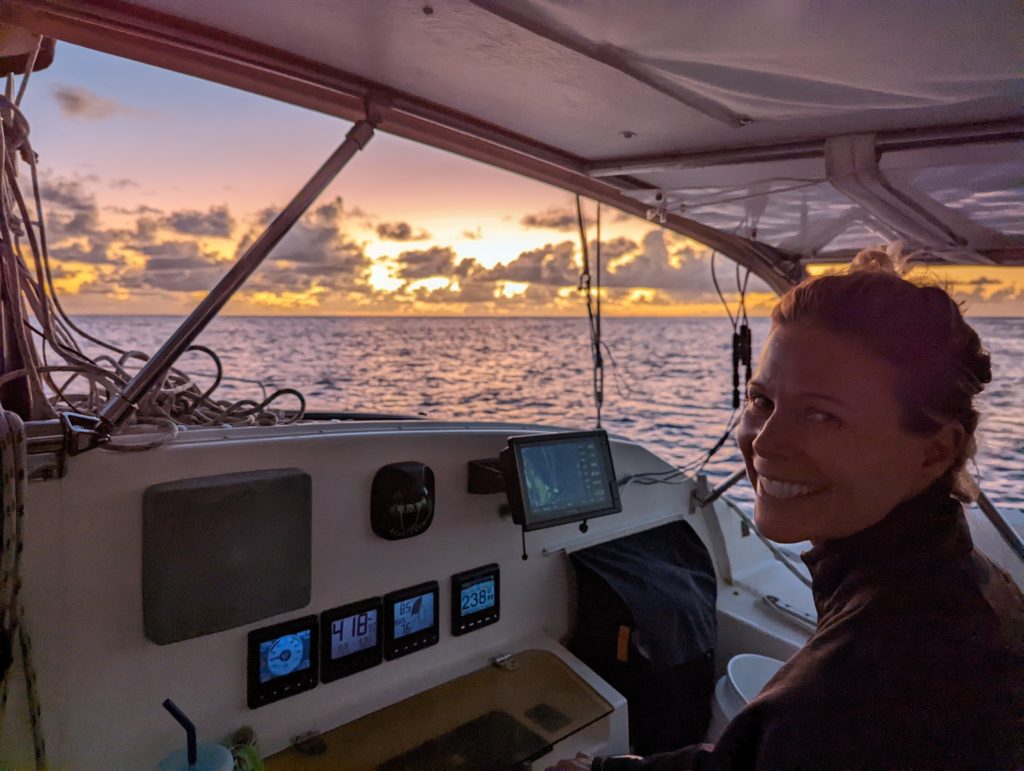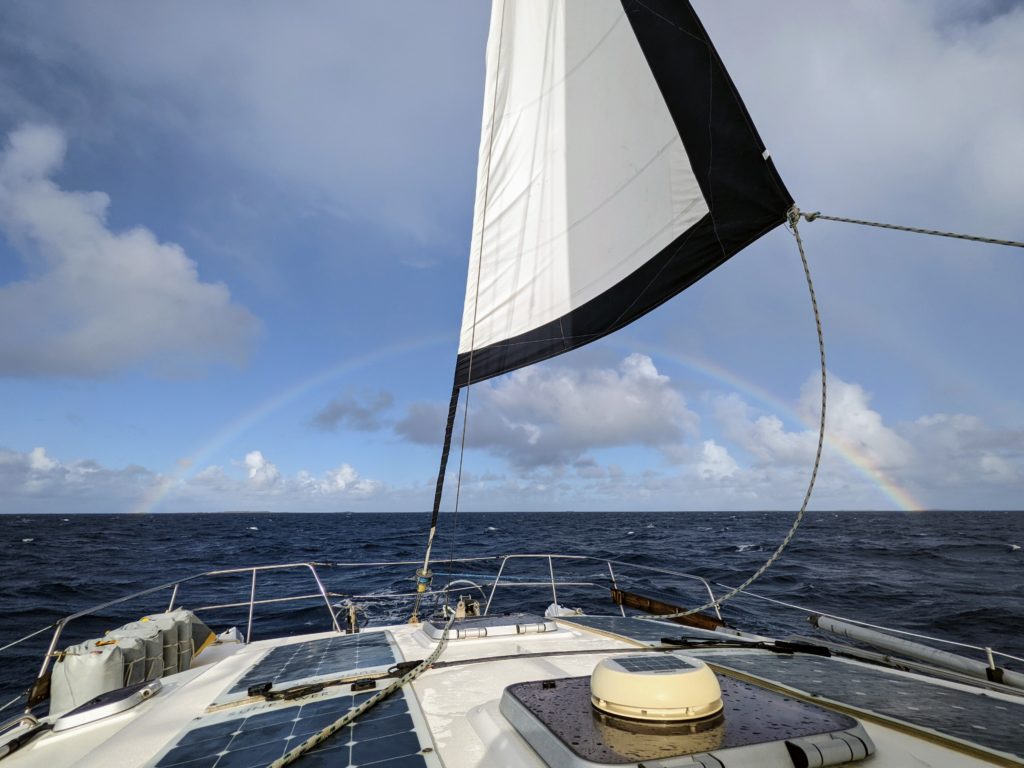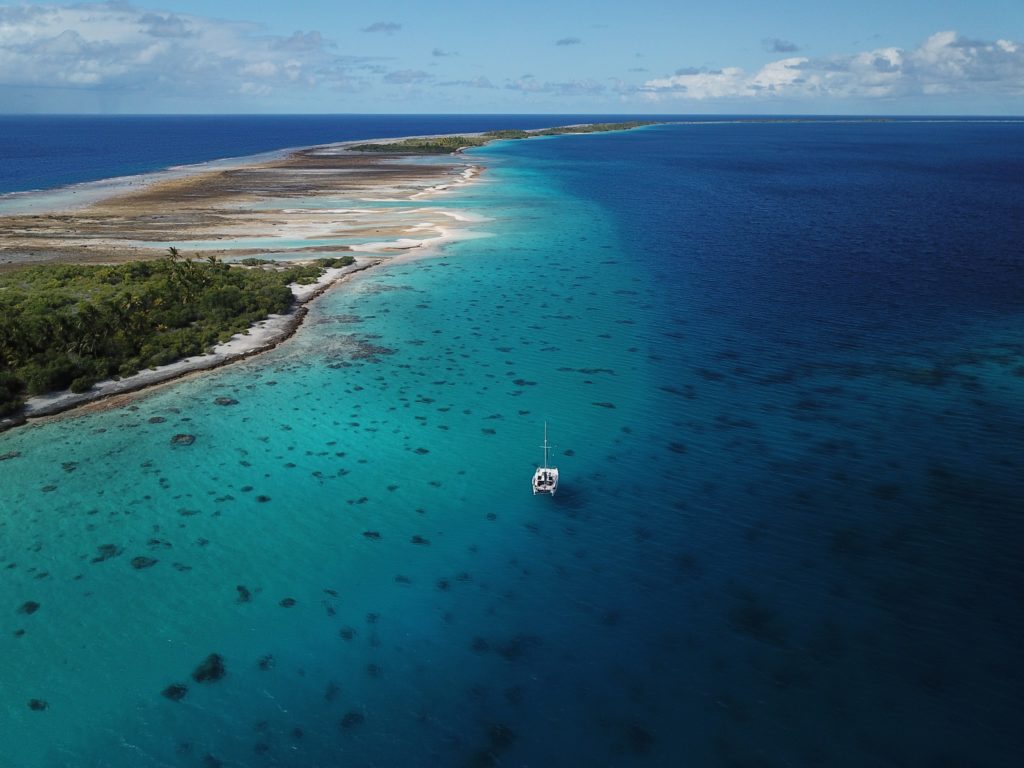Exiting an atoll at twilight is a little unsettling. Despite having seen during daylight that the route we were retracing was clear of all the coral heads poking up to just under the surface, we were keenly aware that they were out there and that we could not see them. Still, we made it into the well-charted area around the pass without hitting anything. In the pass itself, we found nearly two knots of outgoing tide, despite arriving half an hour before our “Guestimator” had predicted the transition from incoming tide to outgoing. Fortunately, the wind was light and blowing the same direction as the current, so the water just did some funny dancing, and we got a little boost. Jazz, on the wheel, had strong opinions about this “boost”, and the eddies and strange non-directional waves tossed the boat around. She cranked the steering wheel way further and more often in both directions than anyone should ever have to to follow a straight line in flat-looking water. The resulting adrenaline boost did not help her take her pre-night-shift nap, leaving a very tired Jazz the next day.






We had 16 hours to make 47 miles, so we put out about a third of our sails in an effort to make about three knots. The sail started out idyllic, Andrew’s shift, flat and calm with just enough wind from just behind the beam. That lasted for about five hours, after which Jazz woke up to take the wheel and the current picked up and the wind started to shift unpredictably, rapidly changing direction and speed from ten to thirty knots. With up to four knots of current pushing us from the side, holding course became impossible. The direction the boat was pointed was swinging between thirty and fifty degrees from the direction the boat was actually moving. Sailing sideways sucks.This made for much more hands-on sailing, to put it mildly, and a less restful night. The squalls made for good double rainbows in the morning, though; note that in the last photo, that little triangle is all the sail we had up.


As we approached the atoll, the wind was blowing a consistent twenty-five knots, so slowing down was not going to happen. Nor was a direct approach, as the wind had shifted south. But these two things together allowed us to zigzag into the wind and arrive right at the predicted slack tide. It tuned out that there was still some outgoing tide, and this combined with the significant wind-driven waves made for a wet and uncomfortable entrance. Wet and slow, because the wind was gusting 30 right in our faces. Worse, the south wind meant that our original destination anchorage was going to be a mess, so we spent several hours motoring around the edge of the atoll in short choppy waves to get to the southeast corner. Wet, salty, choppy, and slow, because Villa does not like pointing near the wind.
As we approached the protection of the island, the water flattened out. We were able to drop anchor in eight feet of crystal clear water, far enough from any coral that we didn’t need to float the chain. We were pretty shot at this point, but it was a lovely place to be shot.


We had some fresh vanilla beans from Nuku Hiva, and we used one to make Creme Anglaise. Add that to a box of brownie mix and we were living the dream. We also had to break out our last bag of shrink-wrapped protein-enriched pasta from the states, so there’s another milestone.



We spent a couple of days in this spot, long enough to get the windlass fixed during the shady part of the day. It turned out that the grinding sound was a part of the top of the motor casing, the threaded bit that’s supposed to attach to the bolts that hold the whole thing together. So now the windlass motor only has one bolt instead of two, and the other bolt-hole is sealed up with silicone. That’ll have to be replaced eventually, but you can’t exactly go to the windlass motor store out here; it’ll be fine for now. Along the way we discovered the point of the ring we’d thought was a spacer at the bottom of the motor casing: it keeps the brushes from popping out when you take the cover off!



We snorkeled several times, and found the scattered coral heads reasonably healthy, though most of the fish were juvenile.




We were starting to feel like we had a streak going, seeing sharks every time we interacted with the water. In this case the friendly, black-tipped reef shark, just minding its own business at a comfortable distance.


We saw some excellent angelfish, in this case a regal angelfish.


We were very excited to see another day octopus. It was initially a little skittish about our presence, but it poked its head about a foot out of its little hidey-hole and started changing colors as Jazz dove under and rolled around for it.



Another of the fun rubble-covered sea cucumbers whose actual name we can’t seem to find, and a yellow-margin triggerfish, which are reasonably common here and swim all weird with their rear fins.


Chilling out on rock perches, a slender lizardfish and another camouflage grouper.


The variation in wrasses is huge. Here’s an intermediate checkerboard wrasse, and a sixbar wrasse.


There were a number of cheek-lined wrasse; here’s a juvenile and an intermediate phase.


And finally, here’s a bicolor cleaner wrasse and its friend at a cleaning station, and a young threespot dascyllus.


We still had the paddleboards inflated, from our time in Makemo. So we took a look around the island, and got to see sharks and coral both right at the surface.






We took a little walk along the beach, enjoying the beautiful view and slightly weaponized shells.





Back at the boat, we managed to make something not entirely unlike thom kha kai, with the kafir limes we’d found in Nuku Hiva and dried galangal from Panama City.

When the wind started to shift back towards east, we headed north, and checked out a spot that had been called out in the Soggy Paws guide. We found enough sand to anchor with a floated chain, and flew the drone to check out the coral.




Armed with the above “dive plan”, we strapped on our scuba gear. Jazz’s second stage had been leaking, so we swapped in her spare… and that leaked too! Between that and the short tanks (we’d used the first third in Raroia for our night dive), it was a short dive. That was fine, though, because while there were neat pillars and plenty of big fish, there wasn’t quite as much life as we’d been seeing in other places.



There were plenty of humbug dascyllus.


And of course, we saw a shark, this time the less-friendly whitetip reef shark.


There was a juvenile axilspot hogfish, and a blacksaddled toby.


Here’s a pair of threadfin and one saddled butterflyfish.


A pacific double-saddle butterflyfish, and a moorish idol.


A steephead parrotfish, and another one that might be a roundhead or a tricolor?


And finally, a clam and a (startled!) peacock grouper.


The next morning, we motored a little further west to anchor between the passes. Along the way we passed Sartori, a giant megayacht bahamian-moored to the shore.


We had been debating leaving that same night for Fakarava, but as we dropped anchor, another boater came up to us and invited us to a 4th-of-July get-together on the beach. So we took a lazier afternoon, before getting in the dinghy to try to snorkel the north pass. We liked it so much that we dove it the next day, and those photos will get their own post.
The barbecue was a lot of fun. We saw humans again, and someone brought facepaint. We were surprised to run into Sava, who we’d met in Tahuata, and Atea, who we’d chatted with briefly off the coast of the Galapagos during our crossing.




